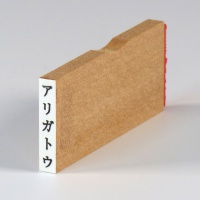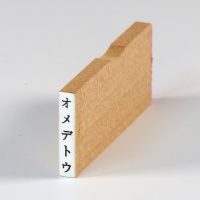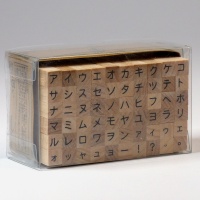As you may know, Japanese language is written using three character sets. One of them is Katakana used to write, among other things, foreign language words and is easily read by non-Japanese speakers.
So how do you write in Japanese?
Kanji are the complex characters adopted from Chinese. They represent a whole concept, idea or word and may have multiple meanings and pronunciations depending on their context. For non-Japanese, Kanji is notoriously difficult to master.
Hiragana characters are easier to remember and form a set of phonetic sounds that, along with Kanji, are used to write normal Japanese words.
However, the third character set, Katakana, whilst also being a set of phonetic kana, has a quite specific use and is not normally used to write true Japanese words. In spite of that, you will see it all the time, alongside Japanese text in newspapers, on television, on product packaging and in menus - all over the place!
Most people who have picked up a little Japanese know that Katakana is used for writing non-Japanese words but did you know that it has other uses and an interesting historical origin?
Ancient origins of Katakana
Although nowadays we are used to seeing Katakana used for writing modern words such as terebi テレビ (television) or sandoichi サンドイチ (sandwich), Katakana was first developed in Japan as long ago as the Heian Period (794–1185 CE).
It was created by Buddhist monks and scholars as a shorthand or simplified system for writing the Chinese characters which were the basis of written communication at the time.
The scholars would extract parts of complex Kanji to represent syllabic sounds which could then be used to annotate Chinese texts for pronunciation and grammatical purposes. These simplified characters were easier and quicker to write, helping facilitate study and teaching.
This original purpose of Katakana was quite academic but over time it evolved and became an integral part of the Japanese writing system. Even in more recent history, however, its use was still quite distinct from how it is used today.
For example, historically Katakana was often used in government documents, official communications and academic papers because its sharp, angular appearance was considered more formal than Hiragana, which was seen to have a softer, more feminine connotation.

In these official contexts, Katakana served to give the text a serious or authoritative tone.
Katakana was also widely used to annotate Kanji, especially in educational texts. This was similar to how Hiragana is used for furigana today. Katakana helped readers pronounce Kanji, particularly in scholarly or religious contexts, where understanding Chinese-derived vocabulary was crucial.
Then later, as Japan began to modernize during the Meiji Era (1868–1912), Katakana played an essential role in transcribing scientific and technical terms. During this time of Western influence, it was the go-to script for these specialist foreign words.
Gradually, Katakana took on its modern use for writing foreign names and more everyday foreign words, the sorts of things one might encounter when travelling or meeting people from overseas. The script's flexibility made it a good tool for transliteration, allowing Japanese speakers to approximate the sounds of non-Japanese words.
Overall, up to the early 20th century Katakana was more commonly used in formal, educational and scientific communication. However, after World War II, with language reforms and the standardization of writing practices, the function of Katakana became more focused on foreign words, onomatopoeia and modern language.

The post-war period
After the Second World War, Japan underwent significant cultural and technological change, which sparked discussions about how to handle the influx of new concepts, particularly those related to Western technology and culture.
With rapid modernization and a strong influence from the West, there were debates among academics and government officials about how foreign words and ideas could be integrated into the Japanese language.
There were two main schools of thought:
Some argued for inventing a new Kanji or modifying an existing Kanji character to uniquely represent each new technology or concept, creating a new Japanese word. However, this approach fell out of favour as creating a new Kanji each time would complicate the writing system and could become quite impractical in a fast-moving modern era.
But, of course, Japan already had a system for phonetically writing unfamiliar words. Many believed that using existing English words written in Katakana would be the most efficient way to handle new concepts, especially since the English language was becoming more globally dominant.

Katakana won the day as the more practical, popular and pragmatic solution.
The system was flexible and could easily adapt to the rapid pace of technological advancements and cultural change. The result is that today Japanese has a significant number of commonly used foreign loanwords, especially in fields like technology, fashion, gaming and cuisine.
Cultural resistance to foreign influence
Although it seems that this transition to using English and other foreign words came organically, understandably there was (and still is to some extend) some resistance to so easily absorbing this foreign influence.
Language is after all closely tied to national identity and cultural heritage. Some traditionalists worry that an overreliance on foreign words, especially English, threatens the unique nature of the Japanese language. This must have been particularly sensitive to Japanese people after World War II, when Japan was grappling with rebuilding its national pride and identity in the face of a strong US influence and occupation.
In recent decades, debates about foreign loanwords have continued, especially as more English terms infiltrate everyday Japanese, often in business, technology and pop culture.
For instance, many older Japanese people find the increasing use of English loanwords challenging. They can be difficult to understand or cause confusion, especially if the concepts they describe are new or if the pronunciation deviates from the original English. Even to an English speaker, understanding words written in Katakana can be like decypering a code!

Japan continues to balance the pressures of globalization with the desire to preserve cultural and linguistic heritage. And while many Japanese people, especially younger generations, embrace the use of English words for their modern and cosmopolitan feel, there remains a segment of society that advocates for caution and more deliberate language use.
Nevertheless, the integration of English into Japanese is generally seen as inevitable and the way Japan has sought to remain open to outside influence and embrace a flexible modern system is to be commended.
What is modern Katakana?
Nowadays, as we have seen, Katakana is primarily used for foreign loanwords and when special emphasis is required. It’s also common to see Katakana used for onomatopoeia and sharp exclamations in manga, video games, gameshows and advertising.
With a Katakana table to hand, English speakers with no Japanese skills at all can recognise certain words that you might see around you in Japan.
For example, words like コンピュータ (konpyūta, "computer"), ハンバーグ (hanbaーgu, "hamburger") and カメラ (kamera, "camera") are commonly used in Japan and can usually be easily understood since they are just transliterations from the English.
It’s also common to see Katakana on restaurant menus, particularly when they serve cuisine that is not Japanese. You might see:
- ビール (bīru, beer)
- ピザ (pizza)
- スパゲッティ (supagetti, spaghetti)
- アイスクリーム (aisukuri-mu, ice cream)
Other foods like カツカレー katsu curry and ラーメン ramen are also written in Katakana since, although people might think of them as Japanese food, the names actually originate from elsewhere.
As you can see, not all words written in Katakana originate from English, even though English speakers might be familiar with their meaning. Here are a few that come from other languages and it’s the English speakers that might have difficulty understanding them!
- アルバイト arubaito: From German 'arbeit' meaning part-time job though its meaning in Japanese has come to refer to part-time work.
- メルヘン meruhen: From German 'märchen' meaning 'fairy tale'.
- プルコギ purukogi: Meaning the Korean marinated beef dish bulgogi.
- チャーハン chāhan: From the chinese chǎofàn fried rice.

Onomatopoeic words, common in Japanese, can be understood because of the sound they make but are not really words, so they are also written in Katakana. Examples are ワンワン (wanwan, a dog's bark) or ガタン (gatan, the sound of a train clattering). You can find out more about Japanese onomatopoeia in my previous blog.
Another way that Katakana might be used is in advertising and branding or for text that needs special emphasis. I suppose it could be likened to spelling out an uncommon word or name phonetically so that there’s no mistaking how to pronounce it. For this reason, even in Japan you see Japanese-sounding company names such as Toyota or electrical superstore Yodabashi written in Katakana.
Japanese adaptability and a flexible attitude
This adaptability of the Japanese language is remarkable and reflects Japan’s long history of absorbing and integrating foreign elements into its culture while still preserving its core identity and cultural strength.
This flexible approach has been successful for several good reasons.
One is that Katakana makes it easy for the Japanese to seamlessly incorporate foreign words as they enter into common use. Unlike in some languages where foreign words often feel more alien, the use of Katakana makes these loanwords feel distinctly Japanese even if their pronunciation is heavily influenced by English or other languages.
The distinctive look of Katakana is also a visual aid when reading Japanese text. The use of the three different scripts, Kanji, Hiragana and Katakana, separates native and foreign words. This signals to both Japanese and non-Japanese speakers which words are in fact foreign and not to look for a ‘Japanese’ translation.

To English people learning Japanese, reading Kanji characters can be very difficult since most of them have multiple readings depending on their context. To us, reading Hiragana and Katakana is much simpler, especially if you have your Japanese dictionary to hand! And if a particular word is written in Katakana, you know that it’s usually a word that you’ll be familiar with in your own language.
My Japanese teacher once told me, however, that to Japanese people, it’s much easier to read text in Kanji and Hiragana since you can get the meaning very quickly even if you’re not sure how to pronounce it. Katakana can be harder to figure out because you have to put together the sounds and make the mental association with a foreign word that sounds the similar.
Even for foreigners though, Katakana can be difficult to figure out because of the way the sounds have been adapted to fit the phonetic sounds of Japanese kana. There is Katakana in the images throughout this article, can you figure out what the words are supposed to be?
In spite of this difficulty, using Katakana is a highly practical way for Japanese to incorporate new words and I think this shows a pragmatic flexibility and openness to outside influence that other cultures might not be so willing to accept.






